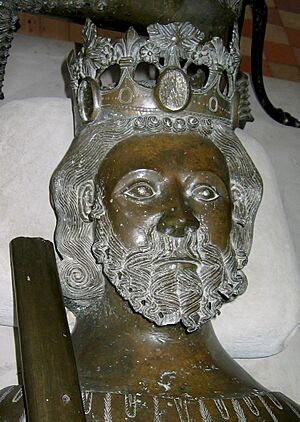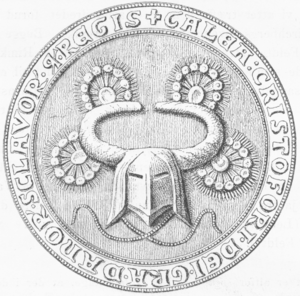Christopher II of Denmark facts for kids
Quick facts for kids Christopher II |
|||||
|---|---|---|---|---|---|

Tomb effigy at Sorø Abbey
|
|||||
| King of Denmark and the Wends | |||||
| Reign | 1320–1326 | ||||
| Coronation | 15 August 1324 Vordingborg |
||||
| Predecessor | Eric VI Menved | ||||
| Successor | Valdemar III | ||||
| Junior king | Eric Christoffersen | ||||
| Reign | 1329–1332 | ||||
| Predecessor | Valdemar III | ||||
| Successor | Vacant Valdemar IV Atterdag |
||||
| Junior king | Eric Christoffersen | ||||
| Born | 29 September 1276 | ||||
| Died | 2 August 1332 (aged 55) Nykøbing Castle |
||||
| Burial | Sorø Abbey | ||||
| Spouse | Euphemia of Pomerania (m. between 1300 and 1307) |
||||
| Issue among others... |
|
||||
|
|||||
| House | Estridsen | ||||
| Father | Eric V Klipping | ||||
| Mother | Agnes of Brandenburg | ||||
Christopher II (Danish: Christoffer 2.; born September 29, 1276 – died August 2, 1332) was the King of Denmark for two periods. He ruled from 1320 to 1326 and again from 1329 until his death. He was a younger son of King Eric V. Many people connect his time as king with big problems for Denmark. His rule almost led to the complete collapse of the Danish kingdom.
Contents
Becoming King of Denmark
Christopher was the brother of King Eric VI, who ruled before him. This meant Christopher could become king one day. When he was younger, he was known as the Duke of Estonia. He supported his brother's decisions. For example, he helped arrest Archbishop Jens Grand in 1294.
However, Christopher later joined groups that were against the king. He had to leave Denmark. When his brother Eric died in 1319, Christopher was in exile.
The powerful Danish nobles, called magnates, wanted a king who wasn't too strong. They chose Christopher to be king in January 1320. But first, he had to sign a special agreement. This agreement was called a håndfæstning. It was the first time such a document was used when a king was crowned.
Challenges of His Reign
Christopher became king of a country that was almost bankrupt. Many parts of Denmark were already "mortgaged." This means they were given as a promise for money borrowed from German and Danish nobles.
The håndfæstning made it very hard for Christopher. It limited how much he could tax people. It also demanded that he pay back all the money owed. He couldn't make big decisions without the nobles and bishops agreeing. The agreement also gave many special rights to the nobles and the church. For example, the king couldn't put a bishop in jail without the Pope's permission. Church land couldn't be taxed. Nobles could also charge more money from peasants. This agreement made the king much weaker than the nobles.
Even after signing the agreement, King Christopher tried to rule as if it didn't exist. He couldn't tax the church or Danish nobles. So, he put heavy taxes on German areas and on peasants. He also tried to fight wars against cities and areas in northern Germany. This led to more debts and more taxes. Soon, he was fighting with both the church and the powerful nobles.
Overthrown and Exile
In 1326, a rebellion started. Danish nobles teamed up with Gerhard III, a Count from Holstein-Rendsburg, and John I, Count of Holstein-Kiel. Christopher was forced to give up his throne and leave the country.
A 12-year-old boy, Duke Valdemar of Southern Jutland, became the new king. Count Gerhard became his main advisor. They made Valdemar sign an agreement that separated Southern Jutland from Denmark forever. This meant the King of Denmark could never rule there again. A Danish nobleman, Knud Porse, took the area of Halland for himself.
But the nobles soon started arguing over who got which parts of Denmark. This broke apart the alliance that had removed Christopher.
Return to Power (Briefly)
Christopher lived in exile until 1329. But Denmark became very chaotic under the nobles' rule. This gave Christopher another chance. There were disagreements between Count Gerhard and his cousin, John the Mild. John was also Christopher's half-brother.
Suddenly, Christopher returned with 2,000 German knights. He was at Vordingborg. But his forces were surrounded and had to surrender. After a peasant uprising in Jutland was put down, the peasants in Skåne asked King Magnus IV of Sweden to rule them. He agreed, and Denmark almost stopped being a united kingdom.
Christopher was made king again in 1329–1330. This time, he worked with Count John. But he was just a puppet king. Most of his country was mortgaged. He had no real power. For example, Jutland was mortgaged for a huge amount of silver. Count Gerhard took all of Jutland for himself. Count John did the same for Funen and Zealand.
In 1331, Christopher tried to use a fight between Count Gerhard and Count John to his advantage. He joined Count John. But Christopher's side lost badly in a battle at Dannevirke. After this, Christopher was allowed to keep the title of king, but he had no power at all. He was given a small house in Sakskøbing on Lolland. But even that was burned by German soldiers. Christopher was put in prison at Ålholm Castle on Lolland. He died there the next year, a broken man. He was buried at Sorø Abbey.
After Christopher's death, Denmark stopped being a formal kingdom for eight years. Different parts of the country were controlled by German rulers who held the mortgages.
Legacy and Impact
Historians have often been very critical of Christopher II. He is sometimes seen as a weak and unreliable king. People often say he was "the king who mortgaged Denmark to the Germans."
However, he was also continuing policies from the king before him. Borrowing money by mortgaging parts of Denmark was a common practice for both nobles and kings. Christopher wasn't just a passive ruler. The power of the Danish and German nobles, and their cooperation with the church, greatly limited what he could do.
Family
Christopher II had children with his wife, Euphemia of Pomerania, whom he married before 1307:
- Margaret (1305–1340); she married Louis V, Duke of Bavaria.
- Eric (1307–1331); he married Elizabeth of Holstein-Rendsburg.
- Otto, Duke of Lolland and Estonia (1310-after 1347).
- Agnes (died 1312); she died young.
- Heilwig (born around 1315).
- Valdemar (1320–1375).


